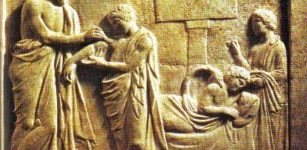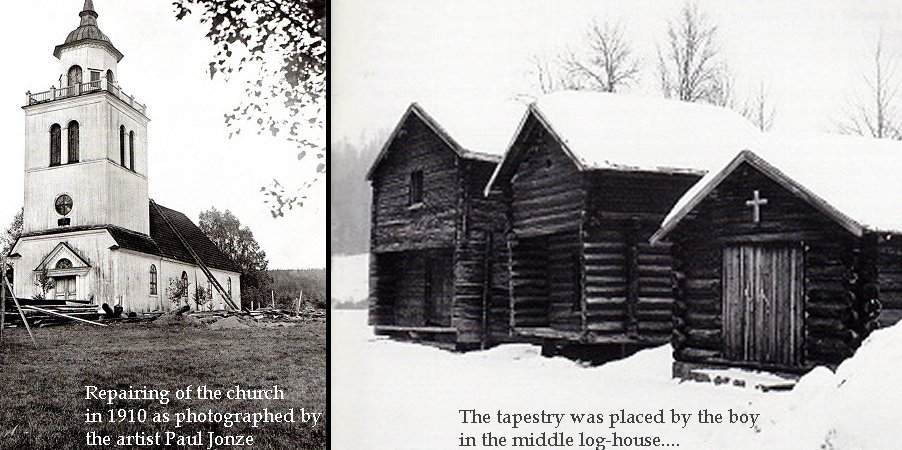Överhogdal Tapestry: Amazingly Well-Preserved Ancient Textiles With Norse And Christian Motifs
A. Sutherland - AncientPages.com - The Överhogdal Tapestry (in Swedish: Överhogdalstapeten) represents a group of amazingly well-preserved and the most complete ancient textiles found in Europe.
This imaginative creation with strong colors and distinctive shapes was created by an unknown artist. The tapestry was accidentally found by a fourteen-year-old boy helping in the sacristy of the local church at Överhogdal, a small town south of Östersund, Sweden in 1909.
Unaware of what he really found, the boy put the dirty bundle in the church's log house. Next year, the textiles were finally brought by the artist Paul Jonze to Östersund.
The fascinating Överhogdal tapestry composed of five assembled lengths was cleaned, repaired provisionally, and for the first after many centuries, they revealed their beauty.
The artwork covers two-square-meter textiles and depicts stylized animals, dark blue and red horses, birds, and people. There is also a ship, a tree, and mysterious inscriptions, perhaps made in runic script, according to one of the earliest interpretations of the artwork.
The large animal and smaller human figures seem to rush by a tree, which could be the mighty ash Yggdrasil, a massive tree central to nine worlds in Norse mythology. Some scholars have suggested that what is shown is the Christianization of the region Härjedalen.
 Överhogdal tapestries found 1909 in Överhogdal, Sweden. Public Domain
Överhogdal tapestries found 1909 in Överhogdal, Sweden. Public Domain
However, today the dominant theory, given the radiocarbon dating of the tapestries, is that the tapestry depicts the Ragnarok, the downfall of the world - a series of events foretold to occur in Norse mythology.
Research has established that the figures are made of plant dyed wool, which is interwoven with the linen with a special technique.
At first, it was believed these wool tapestries were woven in the days of the Vikings, between 800 AD and 1000 AD, as radiocarbon dating suggested in 1991.
Left: In 1910, the artist Paul Jonze visited Överhogdal and found the Överhogdal tapestry in a neighborhood near the church. Jonze took the picture of the church where the repair was going on at the time. Right: The tapestry was placed by the boy in the middle log-house. Image source
However, the preliminary dating of the textiles was updated in 2005 and it turned out that the tapestries date back to the period between paganism and Christianity in the Nordic countries around the year 1000-1100, in other words, the end of the Viking Age and the beginning of the Middle Ages. It means the textiles were created between 1040 and 1170 AD.
Are Motifs Taken From The Book Of Revelation Or Ragnarok Foretold In Norse Myths?
Different theories suggest that the Överhogdal tapestries depict imagery of both Norse and Christian origin.
The contents of the pictures have been much debated; some characters are related to paganism, clearly featuring the appearance of Odin's horse Sleipnir, while other pictures represent Christian imagery. The four surviving sections of the tapestries have 323 figures of people and 146 and 3 partial animals, all generally moving in the left direction.
Viking ship – motif from Overhogdal Tapestry. Image credit: Jämtlands läns Museum, Jamtli
People, horses, and various types of fairy-tale animals appear to be heading towards something and passing houses, churches, ships, and trees. One of these trees could be Yggdrasil.
Some scholars have suggested that what is shown is the Christianization of the region Härjedalen. It has been proposed that some of the motives are taken from the Book of Revelation.
Today the dominant theory is that the tapestry depicts Ragnarok (Ragnarök), a series of events foretold to occur in Norse myths and legends. Ragnarok is described in Völuspá, Völva's prophecy and many similarities between Völuspá and the motives on the tapestry have been found by researchers.
Research has established that the figures are made of plant dyed wool, which is interwoven with the linen with a special technique.
Today, the Överhogdal tapestries are stored at Jamtli Museum in Östersund, where a special room has been furnished for them. The storage conditions are the very best, and the room's architecture creates a Viking Age atmosphere.
Written by – A. Sutherland - AncientPages.com Senior Staff Writer
Copyright © AncientPages.com All rights reserved. This material may not be published, broadcast, rewritten or redistributed in whole or part without the express written permission of AncientPages.com
Expand for referencesReferences:
Nordanskog G. Föreställd Hedendom
Oscarsson, Ulla. Överhogdalsbonaderna
Karlin, Georg. Över-Hogdals tapeten
Sylwan, V. Om brickband : ett bidrag till Överhogdals- och Skogstapeternas teknik historia
More From Ancient Pages
-
 Ancient Mystery Of The Enigmatic ‘Cat Men’ – Advanced Prehistoric Machines Or Humanoids? – Part 2
Ancient Mysteries | Jan 20, 2021
Ancient Mystery Of The Enigmatic ‘Cat Men’ – Advanced Prehistoric Machines Or Humanoids? – Part 2
Ancient Mysteries | Jan 20, 2021 -
 Stunning Facial Reconstruction Of ‘Siberian Tutankhamun’ And His ‘Queen’ Who Died 2,600 Years Ago
Archaeology | Jan 12, 2021
Stunning Facial Reconstruction Of ‘Siberian Tutankhamun’ And His ‘Queen’ Who Died 2,600 Years Ago
Archaeology | Jan 12, 2021 -
 Celts In Poland: Iron Smelting Furnaces Used By Celts 2,400 Years Ago – Unearthed
Archaeology | Nov 30, 2019
Celts In Poland: Iron Smelting Furnaces Used By Celts 2,400 Years Ago – Unearthed
Archaeology | Nov 30, 2019 -
 Pyramid Of Unknown Ancient Egyptian Queen And Hundreds Of Mummies Discovered In Saqqara
Archaeology | Nov 17, 2022
Pyramid Of Unknown Ancient Egyptian Queen And Hundreds Of Mummies Discovered In Saqqara
Archaeology | Nov 17, 2022 -
 Hunter-Gatherer Genes Helped Early European Farmers Survive Disease – New Study
Archaeology | Mar 24, 2023
Hunter-Gatherer Genes Helped Early European Farmers Survive Disease – New Study
Archaeology | Mar 24, 2023 -
 Ancient Egyptian Temple, 30 Mummy Cards, 85 Tombs And Surveillance Points From The Era Of Ptolemy IIIs Discovered In Sohag
Archaeology | May 5, 2022
Ancient Egyptian Temple, 30 Mummy Cards, 85 Tombs And Surveillance Points From The Era Of Ptolemy IIIs Discovered In Sohag
Archaeology | May 5, 2022 -
 Controversial Evidence – Ancient Chinese Visited America 2,500 Years Ago
Civilizations | May 9, 2015
Controversial Evidence – Ancient Chinese Visited America 2,500 Years Ago
Civilizations | May 9, 2015 -
 Curious Encounter Between Inuit And Vikings Led To Something Surprising That Shaped History
Featured Stories | Aug 4, 2024
Curious Encounter Between Inuit And Vikings Led To Something Surprising That Shaped History
Featured Stories | Aug 4, 2024 -
 Why Did Ancient Romans Build So Many Straight Roads?
Ancient History Facts | Aug 9, 2017
Why Did Ancient Romans Build So Many Straight Roads?
Ancient History Facts | Aug 9, 2017 -
 Fossilized Skulls Reveal Relatives Of Today’s Rhinos Had No Horn And Died Out 5 Million Years Ago
Fossils | Nov 2, 2023
Fossilized Skulls Reveal Relatives Of Today’s Rhinos Had No Horn And Died Out 5 Million Years Ago
Fossils | Nov 2, 2023 -
 Gungnir: Odin’s Magical Weapon That Provoked Or Reduced Conflicts In Norse Mythology
Featured Stories | May 12, 2020
Gungnir: Odin’s Magical Weapon That Provoked Or Reduced Conflicts In Norse Mythology
Featured Stories | May 12, 2020 -
 Kantyua And Tantyua – Sacred Tibetan Books Reveal Incredible Lifespan Of The Gods
Artifacts | Mar 18, 2019
Kantyua And Tantyua – Sacred Tibetan Books Reveal Incredible Lifespan Of The Gods
Artifacts | Mar 18, 2019 -
 Mysterious Underwater Ruins In Canada And America – Evidence Of An Unknown Ancient Civilization?
Civilizations | Sep 17, 2020
Mysterious Underwater Ruins In Canada And America – Evidence Of An Unknown Ancient Civilization?
Civilizations | Sep 17, 2020 -
 Why Was It Necessary For Great Physician Hippocrates To Eat Earwax?
Ancient History Facts | Aug 14, 2017
Why Was It Necessary For Great Physician Hippocrates To Eat Earwax?
Ancient History Facts | Aug 14, 2017 -
 Neith – Fearsome Egyptian Mother Of The Gods – Creator Of Sun God Ra, His Archenemy Serpent God Apophis And The Universe
Egyptian Mythology | Jul 9, 2018
Neith – Fearsome Egyptian Mother Of The Gods – Creator Of Sun God Ra, His Archenemy Serpent God Apophis And The Universe
Egyptian Mythology | Jul 9, 2018 -
 Mysterious Ancient Inscriptions Never Meant To Be Read – Biblical Secrets Revealed
Ancient Mysteries | May 17, 2018
Mysterious Ancient Inscriptions Never Meant To Be Read – Biblical Secrets Revealed
Ancient Mysteries | May 17, 2018 -
 Unraveling The Mystery Of Ancient ‘False Doorways’
Ancient Mysteries | May 24, 2014
Unraveling The Mystery Of Ancient ‘False Doorways’
Ancient Mysteries | May 24, 2014 -
 Adad ‘Lord Of Abundance’- Mesopotamian Weather God Who Was Responsible For Fertility, Wealth And Oracles
Featured Stories | Mar 11, 2020
Adad ‘Lord Of Abundance’- Mesopotamian Weather God Who Was Responsible For Fertility, Wealth And Oracles
Featured Stories | Mar 11, 2020 -
 Gigantic Ancient Palace Unearthed In Mexico’s Valley Of Oaxaca
Archaeology | Mar 29, 2017
Gigantic Ancient Palace Unearthed In Mexico’s Valley Of Oaxaca
Archaeology | Mar 29, 2017 -
 Ancient Secrets Of Mistletoe – Sacred Celtic Plant With Magical Powers
Ancient Traditions And Customs | Dec 17, 2024
Ancient Secrets Of Mistletoe – Sacred Celtic Plant With Magical Powers
Ancient Traditions And Customs | Dec 17, 2024



